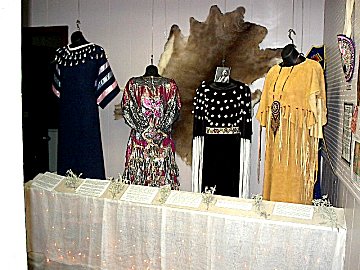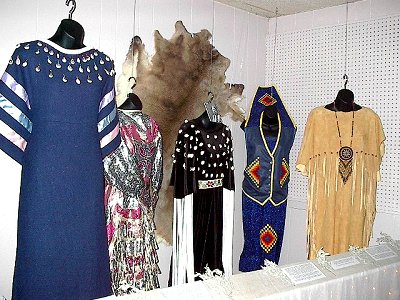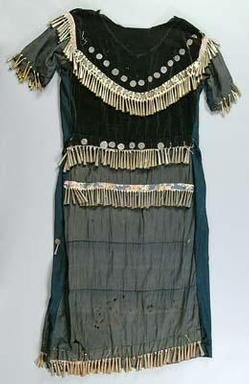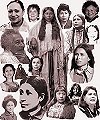 |
Ancient
Voices
A
Museum to honor the least known people in North America,
the Original Tribal Women |

The
dresses that are in the actual museum in Pipestone
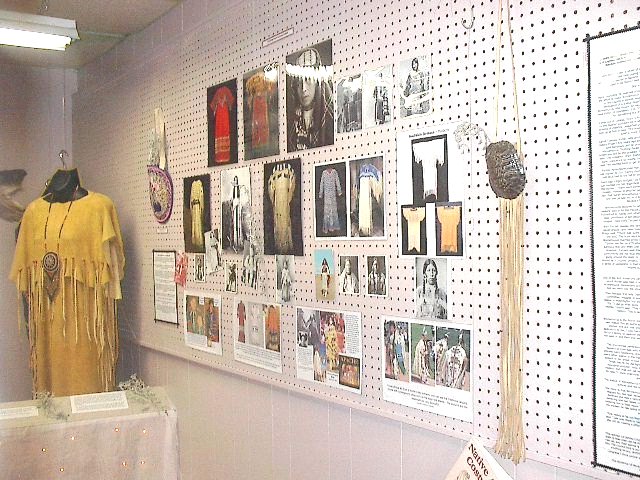
The display of various clothing styles
This page shows
various clothing pieces that are interesting and maybe have a
story of their own to tell!
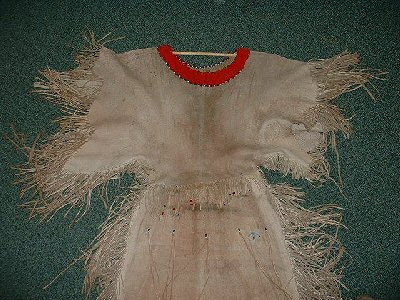 |
Buckskin Plains Dress
This buckskin dress was found in the south west of America, it was offered to the Little Feather Center to be used as a feature in their old museum. The reason this was done was that on this dress were stains from Catlinite dust, the stone that Pipes are made from.
This is an old dress, and so it goes to prove that women did work with the stone, even though it is said that they never worked with it.
I don't know what happened to the dress, but I would love to get it for the 'Ancient Voices' museum
|
 |
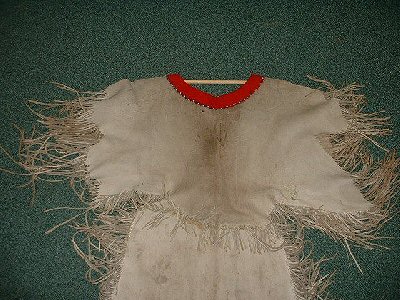 |
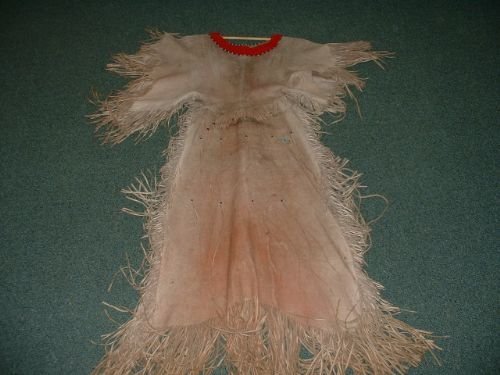
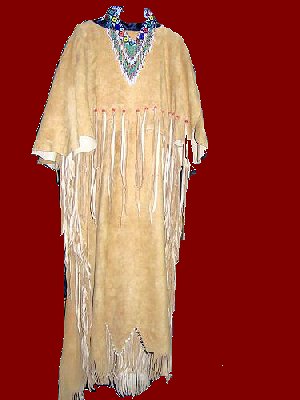 |
This deerskin dress will be displayed in the physical museum. It was hand made by Orlene, a Hunkpapa woman. There is no sewing on this dress, it is all put together using strips of hide threaded through both sections and secured on the outside. This is the style that was used before actual sewing came in, pre 1700.
This is a beautiful dress and our thanks go to Orlene for working with us on this. Orlene's great-grandmother taught her mother how to make this style of dress, and she taught Orlene, so it is a tradition passed down in their family. So thanks to all of the women who taught each younger generation the traditions. The crafts, and artwork don't die when they are passed on.
|
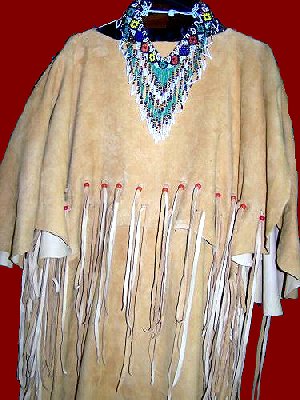 |
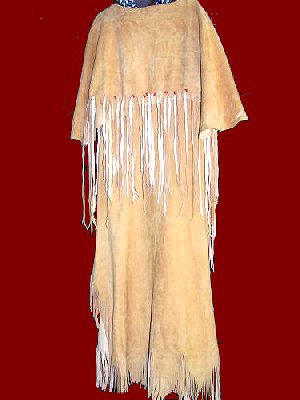 |
Tear Dress (Cherokee)

The Cherokee Tear Dress is the official tribal dress for women of the Cherokee Nation of Oklahoma by proclamation of the National Council. The Cherokee Nation seems to be the only tribe to legislate a specific style of clothing as the official tribal dress. The Cherokees of North Carolina have a completely different style of dress.
Because of the hardships of the Trail of Tears, 1838-39, often Cherokee women did not have scissors with which to cut material. In lieu of cutting, they tore the material into square or rectangle pieces that were then sewn by hand. Thus originated the term for the "tear" dress that reflects a double meaning; "tear" for the torn cloth; "tear" for the tears shed during the terrible ordeal on "the trail where they cried." The tear dress has become the traditional dress of Cherokee women and is now worn in remembrance of the Trail of Tears.
This style of dress was not designed until 1975, so it wasn't around when the Trail of Tears happened.
A Cherokee Tear Dress must have these basic elements of construction and design:
- All pieces of the dress must made of squares and rectangles; The bodice must be gathered onto a shoulder yoke and open up the front;
- There must be square gussets under the arms where the sleeves attach to the bodice;
- There must be a stand up ruffle where the lower bodice and sleeve are attached to the yoke and where the skirt flounce is attached to the upper skirt panels;
- There must decorative fabric bands at certain places on the dress, which are over each shoulder of the yoke, around each sleeve, and around the upper shirt just above the flounce.
- Ribbon is not supposed to be used on one all of the decoration is meant to be torn
Every tear dress is one-of-a-kind original creation and is usually made to fit the individual
For more information on the Tear Dress please go to this site
Jingle Dress
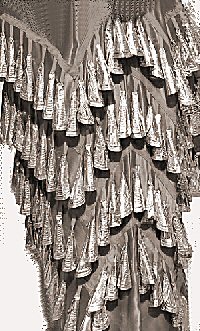
As the story goes, a medicine man's granddaughter was very ill. He had a dream in which a spirit wearing the jingle dress came to him and told him to make one of these dresses and put it on his daughter to cure her. When he awoke, he and his wife proceeded to assemble the dress as described by the spirit of his dream. When finished, they and others brought his granddaughter to the dance hall and she put on the dress. During the first circle around the room, she needed to be carried. During the second circle around the room, she could barely walk and needed the assistance of several women. The third circle around the room she found she could walk without assistance and during the fourth circle around the room, she danced.
The jingle dress is made of a cloth, velvet or leather base adorned with jingles made out of a shiny metal. Traditionally and still common today, the jingles are made from the lids of snuff cans. These are bent and molded into triangular bell shapes and attached to the dress with ribbon or fabric in a pattern designed by the dancer. It takes between 400 and 700 jingles to make an adult jingle dress. (Some versions of this story say 365 jingles for each day of the year.)

|
An early Museum piece Jingle Dress
A Plains jingle dance dress, with a black velvet top, rows of metal cones arranged as fringe on front and rear, applied tin buttons, and flowered material .
Image courtesy of Robert S. Brunk Auction Services Inc.
|
Sidefold Dress
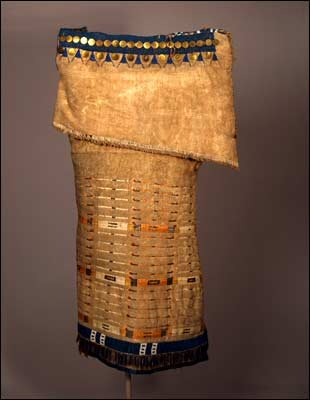
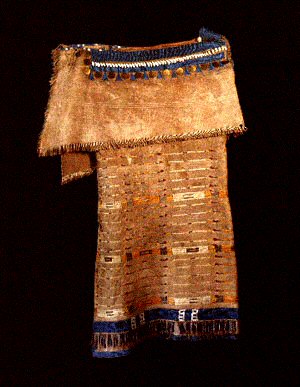
|
Sidefold Dress, Upper Missouri/Northern Plains.
Central Plains/Upper Missouri River (Sioux or Cheyenne?)
Large mammal hide, horse hair, porcupine quills, bird quills, unidentified plant fiber, glass beads, brass buttons, cowry shells (Cyprea montea), tin-plated tinklers, red wool, pigments, glue sizing, woven wool tape
L:119 cm W:78 cm
PM# 99-12-10/53047
A rare side-fold dress, a type made and worn by women living west and north of the Great Lakes during the eighteenth and early nineteenth centuries. Few such dresses survive in museums. Adorned with Italian trade beads, indigenous quillwork and pigments, imported Indian Ocean shells, and European brass and metal ornaments, this dress speaks of multiple and intersecting cultural and economic systems.
This elaborate two-piece, side-fold dress is decorated in part with dyed porcupine quills and cowrie shells, materials having a long history of use in native North America (although these cowry, an Indo-Pacific species, must have been imported for trade). The brass buttons, red wool, glass beads, cone tinklers, and pigment were trade goods that came into vogue during the eighteenth and nineteenth centuries. The English gilt brass buttons on the yoke, like the metal trade tokens issued by fur trading companies, were popular decorative elements and status markers during the early nineteenth century. Lewis and Clark noted that brass buttons were more highly sought than all other items save beads.
The yoke of this dress has been impressed into a geometric pattern and then painted with clear sizing or hoof glue, a decorative treatment of hide practiced by several central Plains groups including the Cheyenne and the Hidatsa. The rows of horizontal quill work punctuated by red wool "tufts," as well as the arrangement of the brass buttons, suggest that this dress may have been made by a Cheyenne, Dakota or Lakota woman.
This may be the dress given to the Peale Museum by the Hutter family in 1828 and described in the Peale ledger as a "Soux squaws dress." Clark also acquired a dress on the expedition that he described as "an Indian dress, such as the Soues women ware [sic] in their dances." He presented that dress to first lady Dolley Madison.
Photo by Hillel Burger. © Peabody Museum.
www.peabody.harvard.edu
|
Copyright ©President and Fellows of Harvard College
|
|
|
|
Cloth Plains Dress

image courtesy of Skinner Inc.
A late 19th century Central Plains Lakota woman's trade cloth dress, the blue trade cloth dress with ribbonwork above the selvage edging on the sleeves and bottom, large metal sequins are sewn to the ribbon, the yoke is decorated with rows of cowry shells, includes a cloth belt beaded in "salt and pepper" beadwork.
This type of dress is well-known, everyone has seen photos of such Sioux dresses decorated with dentalium shells or bone “elk teeth”. Similar dresses without the decoration were also made and worn -- usually as less formal attire, but also to dances and ceremonies.
The dress is simple but ingeniously constructed. There are only 5 or 6 main pieces, depending on whether or not there is a shoulder seam in the body of the garment. The main part of the dress is two rectangles of cloth, usually made from the full width of the cloth, selvage to selvage. The sleeves are also simple rectangular pieces of the cloth, and gussets or side-inserts are elongated isosceles triangles. With these straight-sided shapes, a minimum of cloth is wasted. The sleeves, are open at the bottom because the “sleeves” of the old hide dresses also were unsewn there -- and it’s easy to fold the sleeves back and out of the way for messy jobs, or to feed a baby via the large sleeve-opening.
The dark blue, white-edged stroud was the woolen cloth used in making such a dress, and the darker solids and calicos were cotton fabrics used. A woolen dress like this can later be decorated with cowrie shells, dentalia, bone elk teeth- depending upon the owner's s financial situation - to make it into a truly “full-dress” costume.
ACCESSORIES:
- Leggings, beaded in the traditional style.
- Moccasins, with added ankle flaps.
- Belt, tack-studded, concho or plain.
- Shawl or blanket, worn over the shoulders in the usual way for dancing; wrapped about the body in other ways when not dancing. (The long-fringed, lightweight shawl is a modern replacement.)
- Necklaces, braid ornaments, earrings, lowanpi plume (for the eligible only) bracelets (quilled, beaded or metal.)
Copyright © California Indian Hobbyist Association & Rosemary Lessard
Copyright © 2003 Matoska Trading Company Inc. www.matoska.com
Buckskin Dress
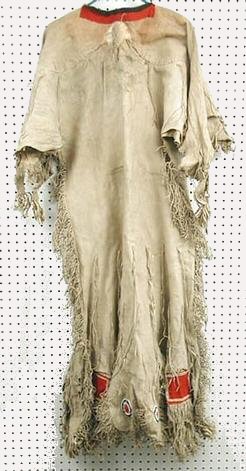 Image courtesy of James D. Julia, Inc.
Image courtesy of James D. Julia, Inc.
|
A Northern Plains Indian woman's deerskin dress. Beautiful, brain tanned deerskin dress with raglan type shoulders and short cape type sleeves. The shoulder yolk is deerskin laced as are the side seams. The center, front and back of the yolk have a small decorative area with the deer hair still on. The neck opening front and back have a narrow band of dark blue cloth and a wide band of red trade cloth. The blue cloth is of the right texture, color and consistency of the period Cavalry uniforms. The skirt is scalloped and decorative with very fine fringe, completely surrounding the circumference. It is decorated on each side with rectangles of trade cloth and deerskin. The center, on one side, has two small spots of red trade cloth and the opposing side has two beaded rosettes 2.25 inches in diameter with a red trade cloth center and white and blue circles surrounding. All the decorations appear to be applied with sinew thread. Both entire side seams have very fine fringe and there are fine hide strings front and back at the chest area and on the lower part of the skirt.
Attached to one of these strings is a very old manila tag bearing the quill ink inscription "INDIAN WOMAN'S DRESS/PRESENTED TO COL. E. RICE, U.S.A./BY WHITE BULL, WAR CHIEF OF THE NORTHERN SIOUX". At the bottom of the tag in the same writing, but very tiny "COL. EDMUND RICE, U.S.A., FEBRUARY 12, 1884".
White Bull was a nephew of Sitting Bull and was reportedly the Indian who claimed to have been the one that killed General Custer. Col. Rice was an important military figure, having been awarded the Congressional Medal of Honor for his gallant actions on the third day of the Battle of Gettysburg, when he was wounded and most of his unit was lost. After the Civil War, Col. Rice was assigned to the Springfield Armory for a time, where he developed the trowel bayonet. During the Indian Wars, Rice commanded several outposts in the West and engaged in many campaigns against the Northern Plains Indians. It was during this time that White Bull presented the dress to him.
© www.p4A.com |
A wonderful exhibit is on show at the Smithsonian museum in Washington DC. Lucky for us they also have a website. The exhibit is about the clothes, the ideas behind the clothes and the traditions that have been handed down to make the dresses of Native American women
http://www.nmai.si.edu/exhibitions/identity_by_design/IdentityByDesign.html
Be prepared to spend a long time on the site is it wonderfully put together. Click on the arrow on the right side of each page.
Thanks Cindy for sending this info to me.
|


